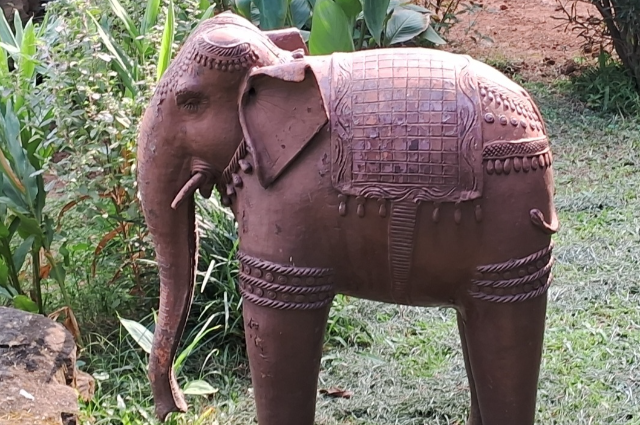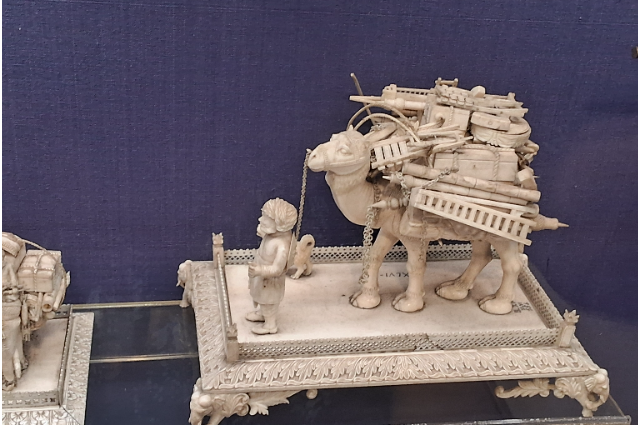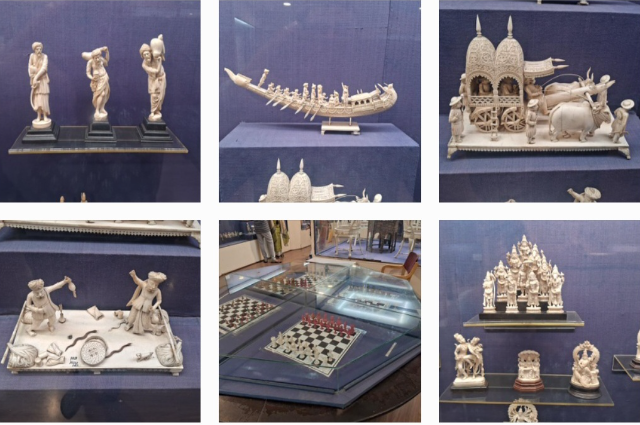
Introduction
Ivory art refers to the practice of carving and shaping ivory—the dense, hard material derived from the tusks or teeth of animals, most commonly elephants, walruses, narwhals, and hippopotamuses—into intricate works of art, functional objects, or decorative pieces. Historically, ivory has been valued for its smooth texture, durability, and creamy white appearance.
Ivory carving is one of the oldest forms of artistic expression, with origins dating back thousands of years. Its use has been documented in various ancient civilizations. Early humans used mammoth ivory to create tools, figurines, and ornaments. The Venus figurines (circa 40,000–20,000 BCE) are some of the oldest known ivory carvings. Ivory was highly prized and used to craft religious objects, amulets, combs, and inlays for furniture in ancient Egypt. Ivory objects have been found in the tombs of pharaohs, symbolizing wealth and status.
Ivory was imported and used for decorative purposes and small sculptures, often depicting gods or animals in the Mesopotamian and the Indus Valley civilizations. In China, ivory carving flourished during the Shang and Zhou dynasties (1600–256 BCE), particularly for ceremonial objects, seals, and jewellery. Southeast Asia developed ivory art as part of Hindu-Buddhist traditions, creating religious idols and temple decorations.
Greco-Roman Period. Ivory was used to craft luxurious items such as diptychs, small statues, and inlaid furniture.
During the Middle Ages, ivory was commonly used for religious purposes, including the creation of reliquaries, crucifixes, and book covers in Medieval Europe. African communities have long used ivory to craft traditional masks, jewellery, and tools, particularly in West and Central Africa, where the ivory trade became intertwined with global commerce.
The origins of ivory art are closely tied to the natural availability of ivory and its properties. Its smooth surface and ease of carving made it an attractive material for early artists and craftsmen. The abundance of elephants and other ivory-producing animals in certain regions also influenced its use. Over time, ivory became a symbol of wealth, power, and cultural sophistication, traded across continents and incorporated into various artistic traditions.
Today, the use of ivory is heavily regulated or banned in most countries due to the devastating impact of the ivory trade on elephant and other animal populations. Modern "ivory art" often uses synthetic ivory, bone, or other materials to replicate traditional styles without harming wildlife. Efforts to preserve historical ivory artifacts focus on their cultural and artistic significance while promoting conservation and alternatives to ivory use.
Antique and relic ivory art

Antique and relic ivory art can still be found, but their trade and ownership are subject to strict regulations and laws due to global efforts to protect elephants and other species threatened by poaching. Here is an overview:
1. Legality and Restrictions
Antique Ivory (Pre-Ban): Many countries allow the sale and ownership of antique ivory, defined as pieces created before specific cut-off dates (e.g., 1947 under the CITES treaty or 1975 in some cases). However, sellers often need to provide documentation proving the age and origin of the item. The sale of modern ivory is generally banned worldwide, with few exceptions for cultural or scientific purposes.
2. Where to Find Old Ivory Art
Auctions: Major auction houses may occasionally feature verified antique ivory items. Some dealers specialize in historic artifacts, including ivory, but ensure the pieces have proper provenance. Relic ivory art is sometimes sold through private collectors or estate sales. While not for sale, museums often display historic ivory art as part of their collections. The internationally famous Salar Jung Art Museum in Hyderabad, Telangana from where the accompanying pictures of this article have been collected by the author has an outstanding gallery of ivory art works for public display.
3. Challenges and Ethical Concerns
Documentation: Antique ivory must be accompanied by clear proof of its legal origin to avoid violating international or national laws. Many people avoid purchasing ivory art due to its association with the endangerment of elephants and other species.
4. Alternatives Bone or Faux Ivory: Artists and collectors often use materials like mammoth ivory, camel bone, or high-quality synthetic substitutes that mimic ivory's appearance without ethical concerns.
Before purchasing or collecting ivory, ensure you research the laws in your country and confirm the item's provenance to avoid legal and ethical issues.
Value of Ivory Art

The value of ivory art artifacts depends on several factors, including their age, craftsmanship, provenance, historical significance, and cultural importance. However, the trade and valuation of ivory artifacts are highly regulated due to global conservation efforts aimed at protecting endangered elephant populations.
1. Artistic Value Craftsmanship: The level of detail and skill in carving can greatly enhance the artistic value of ivory artifacts. Pieces with intricate designs or made by renowned artisans are generally more valuable. Ivory artifacts often hold cultural or spiritual importance, especially in African, Asian, and European traditions. Unique or one-of-a-kind pieces, particularly those from specific historical periods or regions, are highly prized.
2. Historical Value: Artifacts from specific historical periods, such as Ming Dynasty China or Victorian England, can command significant value due to their historical and cultural significance. Provenance (documented history of ownership) adds to the artifact's value, particularly if the piece was owned by a notable individual or linked to a significant event.
3. Regulatory Impact: Many countries have banned or heavily restricted the trade of ivory to combat poaching and protect wildlife. For example the U.S. has strict regulations under the Endangered Species Act. The UK’s Ivory Act 2018 bans almost all ivory sales, with a few exemptions for items of high cultural or historical significance.
These laws significantly reduce the marketability of ivory artifacts, especially modern ones.
4. Market Trends: Legal antique ivory artifacts (often pre-1947 in many jurisdictions) may still hold value in specialized markets or auctions. Modern ivory carvings have little to no legal trade value due to restrictions and ethical concerns.
5. Ethical Considerations: The global push against the ivory trade has influenced the perception of ivory artifacts. Many collectors and institutions are now prioritizing ethical considerations over ownership of ivory items.
6. Appraisal: To determine the specific value of an ivory artifact, qualified appraisers specializing in antiques and fine arts are consulted. Auction houses with expertise in ivory artifacts; or museums or historians for cultural and historical assessments are also consulted for this purpose. It is important to note that legal documentation proving the artifact's age and origin may be required for appraisal or sale in many countries.
Ivory Art: Relic or contraband?

Ivory art occupies a complex and contentious position, as it can be viewed through multiple lenses depending on its origin, age, and cultural context. This unique art form is explored both from the perspectives of relic art and as a contraband.
Ivory Art as Relic Art: Many ivory artworks, particularly those created centuries ago, have significant cultural and historical value. These pieces often represent the craftsmanship, religious beliefs, or societal practices of their time. Such artifacts are typically viewed as relics when they were created in periods before modern awareness of the environmental and ethical implications of ivory trade. Examples include ancient Chinese ivory carvings, African tribal masks, or medieval religious artifacts in Europe. In museums, historical ivory artifacts are preserved as cultural heritage, serving as educational tools and a reflection of past societies.
Ivory Art as Contraband: Since the late 20th century, international conventions like CITES (Convention on International Trade in Endangered Species of Wild Fauna and Flora) have heavily restricted the ivory trade to protect endangered species like elephants and rhinos. Any modern ivory artwork created or traded in violation of these laws is considered contraband. Modern ivory art is often associated with illegal poaching, which has devastating impacts on wildlife populations. Such pieces are considered contraband and contribute to environmental destruction and black-market economies.
Many argue that even possessing or trading historical ivory promotes a market perception that can indirectly support contemporary poaching. The classification of ivory art as relic or contraband often hinges on its provenance. Artifacts with documented histories predating bans may be legally owned and traded in some jurisdictions, while undated or modern pieces are often treated as contraband. For many cultures, ivory holds deep symbolic significance. Balancing cultural preservation with conservation goals remains a key ethical challenge.
Conclusion
Ivory art can be seen as relic art when it holds cultural and historical significance and originates from a time before ivory bans. However, modern ivory art, or historical pieces acquired through illicit means, is considered contraband. The lens through which it is viewed depends on legal, ethical, and environmental considerations.
